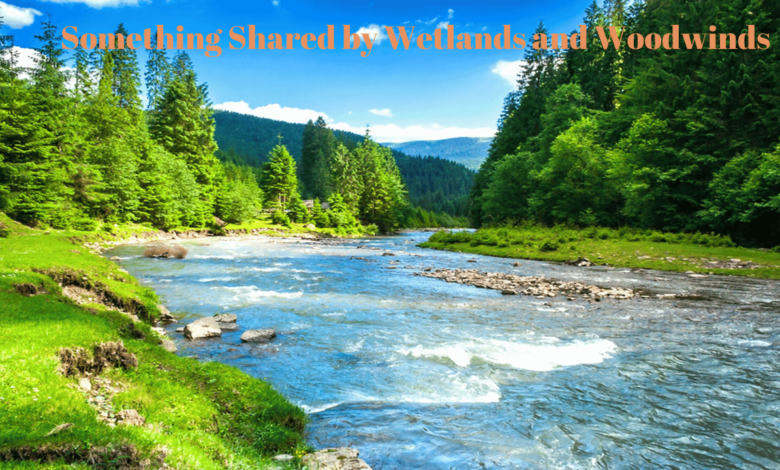Something Shared by Wetlands and Woodwinds: A Symphony of Nature and Music

The connection might become apparent when one thinks of wetlands and woodwinds. Wetlands conjure images of lush, saturated landscapes teeming with wildlife, while woodwinds evoke the delicate sounds of instruments like the flute, clarinet, and oboe. However, a deeper exploration reveals that these two seemingly disparate entities share fascinating characteristics. This article delves into the surprising links between wetlands and woodwinds, highlighting their natural materials, biodiversity, acoustics, ecological importance, and cultural significance.
Natural Materials: The Essence of Life and Music
Wetlands: A Hub of Organic Richness
Wetlands are among the most productive ecosystems on Earth, characterized by their saturation with water and rich organic material. These environments support a diverse range of plant life, from towering trees to delicate grasses, all thriving in the nutrient-dense, waterlogged soil. Organic matter like peat and decaying vegetation contributes to the unique composition of wetlands, fostering a vibrant ecosystem.
Woodwinds: Instruments of Nature
Woodwind instruments, as their name suggests, are traditionally crafted from wood. The choice of wood is critical, as it affects the instrument’s sound quality and durability. Historically, woods like grenadilla, boxwood, and maple have been favoured for their tonal properties and workability. The connection to nature is inherent, as these instruments are born from trees, some of which grow in or near wetland areas. This link to organic materials underscores a shared foundation between wetlands and woodwinds.
Biodiversity and Variety: The Spice of Life and Sound
Wetlands: Biodiversity Hotspots
Wetlands are renowned for their biodiversity. They provide habitat for many species, including amphibians, birds, mammals, insects, and plants. This diversity is crucial for maintaining ecological balance and supporting various life forms. Wetlands are breeding grounds for many species, contributing to their survival and proliferation. The variety of life found in wetlands highlights their importance in the natural world.
Woodwinds: A Symphony of Diversity
The family of woodwind instruments encompasses a broad range of sounds and styles. From the high-pitched tones of the piccolo to the deep, resonant notes of the bassoon, woodwinds offer a rich palette of auditory experiences. Each instrument within the woodwind family has unique characteristics, much like the species in a wetland. This diversity allows for a wide array of musical expressions, mirroring the ecological variety found in wetlands.
Sound and Acoustics: Nature’s Music and Human Craft
Wetlands: Natural Soundscapes
Wetlands are alive with sound. The chorus of frogs, the songs of birds, and the rustling of reeds in the wind—all contribute to a unique acoustic environment. These natural soundscapes are soothing and play a role in the behaviour and communication of wetland inhabitants. The sounds of wetlands are a testament to these ecosystems’ vitality and role in the natural world.
Woodwinds: Crafting Musical Soundscapes
Woodwind instruments produce sound through the vibration of air. The design and material of each instrument affect its acoustics, creating distinct tonal qualities. The craftsmanship involved in making woodwinds aims to harness the natural properties of wood to produce music that can evoke a wide range of emotions. The intricate relationship between material, design, and sound in woodwinds is akin to the natural acoustics of wetlands, where every element contributes to the overall auditory experience.
Ecological Impact and Sustainability: Preserving Life and Craft
Wetlands: Guardians of the Environment
Wetlands play a crucial role in maintaining environmental health. They act as natural water filters, removing pollutants and improving water quality. Wetlands also serve as buffers against floods, absorbing excess water and reducing the impact of natural disasters. They are also vital for carbon sequestration, helping mitigate climate change. The ecological services provided by wetlands are indispensable for the well-being of our planet.
Woodwinds: Sustainable Craftsmanship
The production of woodwind instruments raises questions about sustainability, particularly concerning wood sourcing. Responsible forestry practices and using alternative materials are essential for ensuring that the crafting of woodwinds does not harm the environment. Efforts to source wood ethically and explore sustainable alternatives reflect a growing awareness of the need to balance artistry with ecological responsibility. This parallels the conservation efforts required to protect and preserve wetlands.
Cultural Significance: A Shared Heritage
Wetlands: Cultural and Spiritual Value
Wetlands hold significant cultural and spiritual value for many communities around the world. They feature prominently in folklore, literature, and art, often symbolizing life, fertility, and mystery. Wetlands are also sites of historical and archaeological importance, preserving the remnants of past civilizations. The cultural heritage associated with wetlands underscores their importance beyond their ecological functions.
Woodwinds: Instruments of Cultural Expression
Woodwind instruments have a rich history and are integral to many cultural musical traditions. Woodwinds have expressed various human emotions and experiences, from classical orchestras to folk music. The flute, for instance, has been depicted in ancient art and is one of the oldest musical instruments known to humanity. The cultural significance of woodwinds highlights their role in human expression and the shared heritage of music.
Conclusion: The Interwoven Tapestry of Wetlands and Woodwinds
While wetlands and woodwinds may seem unrelated at first glance, a closer examination reveals that they share several profound connections. Both are deeply rooted in natural materials, exhibit remarkable diversity, create unique soundscapes, and hold significant ecological and cultural value. These shared characteristics highlight the intricate relationship between nature and human creativity. By appreciating the commonalities between wetlands and woodwinds, we can foster a greater appreciation for the natural world and the art it inspires.
Read More: Exploring Ovestæ: The Future of Urban Living




